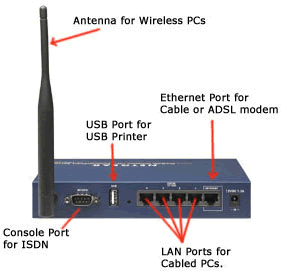Wireless Networking

Having trouble with your home or office wireless internet?
Computer Ambulance can help. Wireless solutions for laptops, desktops, servers, iPhones, Blackberrys and wireless printers/scanners.
We work with most broadband providers including Eircom, Vodafone, UPC, Smart, Magnet and Clearwire.
Our services include:
- Wireless Survey of your Home or Office.
- Setup and troubleshooting of Small Business Wireless Networks.
- Setup and troubleshooting of Home Wireless Networks.
- Identify and analyse WiFi interference and identify any unauthorised access to your wireless network.
- Install analyze and troubleshoot 2.4 GHz and 5 GHz wireless networks.
- Wireless VPN Access
- Installation of modems, wireless access points and wireless routers.
- Installation of wireless network adaptors in desktops, laptops and servers.
- Installation of wired access points with CAT5 and CAT6 data cabling.
Extend the Reach of your Wireless Network
Are there some parts of your house or office where you cannot get wireless internet or areas where signal strength is poor? We can perform a wireless audit of your home or office and set up your wireless network for optimal signal strength.
General Wireless Network Tips
1) For optimal signal strength, try to locate your wireless router in a central location in your house or office.
2) The most secure encryption type for your wireless network is WPA2. Try to use this encryption if your networking hardware supports it.
3) Point the antennas of your wireless PCs towards the wireless router or access point. Although 802.11 technologies do not require a direct line of sight, pointing the antennas this way does tend to increase signal strength.
4) Avoid placing the antennas of access points of PCs near filing cabinets and other large metal objects. They can cause interference and dramatically reduce data throughput.
5) Try out different locations for your access point and wireless PC's. Each house and office is so different that no single configuration can suit them all.
Wireless Printing
Do you have a wireless enabled printer but still cannot print wirelessly?
We setup and configure wireless printers to your office or home network.
Tips for Setting up your Wireless Printer
Are you using the right encryption key? You can obtain your wireless key by logging into the configuration page of your router. (for example, if you have a Netgear router, type in 192.168.1.1 to your browsers address bar)
Do you have the wireless enabled on the printer? Sometimes there is a small wireless on/off button at the front or side of the printer?
Make sure you have the USB cable from your printer to your system disconnected as some printers do not allow you print wirelessly when a USB connection already exists.
If you have setup your printer to be hosted on a computer which is on your wireless network, do not forget that the architecture of the PC's sharing the network must be the same. For example, if you are using a 32-Bit Windows as a host computer for your printer, then any systems running 64-Bit Windows will probably have difficulty accessing the printer as the bit-architecture is different.
If you have setup your printer using DHCP, make sure to set a reservation on its IP address. Otherwise, you might notice the printer going "offline" when its IP lease expires.
Frequently Asked Questions about Wireless
What is the best security to use for my Wireless Router?
From the Least Secure to the Most Secure.
No SecurityNo security is still the factory default setting for many types of router. No router should have security set at this level.
Switching Off SSID
Same as No Security. SSID broadcast can be easily "sniffed" even if it disabled.
MAC FilteringMAC number can be easily be spoofed.
WEP64Easy to "crack".
WEP128
Only a small degree more difficult to crack than 64-bit WEP.
WPA-PSKDifficult to "crack", but still the least safe of all WPA encryption types.
WPA - AES
Best Security. Extremely difficult to break, would need significant resources and labour hours to crack.
(Please Note, the security you choose for your wireless network is dependent on the age and compatibility of your networking hardware.)
Can you explain the difference between Wireless G and Wireless N devices?
Wireless G 802.11g uses a 2.4Ghz signal whereas Wireless N 802.11n uses a 5Ghz signal.
Wireless G networks can have up to three non-overlapping channels with 54 Mbs per channel. Wireless N networks have data rates well above 100Mbs.
A Standard ADSL Modem Router
I have one ADSL broadband internet connection in my office. Can I setup a second modem router in my office, as the signal I receive on the PC systems upstairs is quite weak?
No, this is a common misconception. Each telephone line will only ever allow one modem. There are a number of solutions available to you including setting up a wired access point upstairs, using a Powerline (or PoE) network or upgrading your router to Wireless N with MIMO. Each solution will depend on your current setup and budget.
We run a small coffee shop and would like to provide wireless access to our customers without them having permanent access. What would your recommend?
You could use what is known as a "wireless hotspot gateway". (A good example of this would be the Zyxel N4100). With such a device, you can setup temporary passwords that expire after a certain amount of time. For you own use, you can have a permanent wireless key.
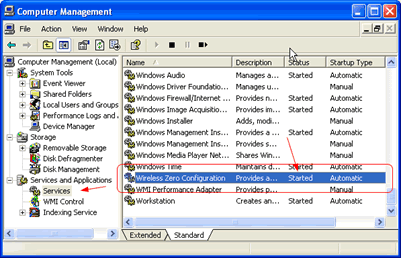
The Wireless Zero Configuration Utility for Windows XP now replaced with WLAN Autoconfig for Windows Vista and 7.
The Wireless Zero Configuration utility on my Dell Windows XP laptop keeps on stopping for no apparent reason?
The third party wireless utility that came with your laptop is probably overriding it. Wireless utilities from Intel, Netgear, etc., tend to conflict with the Windows wirless utility. The best advice would be to uninstall any third-party wireless utilities and use Windows Zero Configuration.
Every couple of weeks I keep on losing the connection to my wireless printer and Windows indicates to me that my printer is offline? What do you think the problem could be?
There are several reasons why this problem could be occurring.The most likely problem is that the wireless printer has got a new IP address assigned by your router and your computer does not fully recognise your printer anymore.
To explain this process further, every network device on your network has an IP address, an IP address is like a unique identifier for every device. Your router uses a system called DHCP (Dynamic Host Configuration Protocol) to assign IP addresses. DHCP issues IP addresses on a temporary basis and just before the IP address expires the all network devices request an address renewal. This often results in the device keeping the same IP address as it had before. However, sometimes the DHCP server in your router assigns a totally different IP address which your computer does not recognise and causes your printer to stop working.
To resolve this, we must tell your system (Windows or Mac) the correct IP address. The easiest way to find the new IP address is to print a copy of the Network Configuration page of your printer. (For example for a HP printer, Use the buttons on the front of the printer to navigate to Setup > Network > Network Settings). Note down the IP address.
Now go to the control panel of your system, select printers, and select the relevant printer. Then select Properties followed by the Ports tab. Then select Configure. Here enter in the new IP address. The link between printer and your system should now be re-established.
Preventing this problem happening in the future
If you wish this problem not to reoccur, you might want to give your printer a static IP address or (depending on your router) you can reserve the IP address for the printer, based on its MAC address. The great thing about this approach is that the printer should now become visible in the router's DHCP table.
I have a printer connected to my Windows Vista desktop PC that is shared. This printer is shared wirelessly with my new top of the range Dell XPS Windows 7 laptop. Unfortunately, even though the printer has a static IP address, the Windows 7 laptop keeps on losing the connection to the printer?
The most likely problem here is that you are trying to share a printer with a 32-Bit driver with a system that has 64-Bit architecture. The best solution to this problem is to go to C:\Windows\system32\spool folder. Then go to the printer folder and under Sharing and Security add "Everyone" to the permissions list and give them full rights.
I use my Windows 7 laptop for video-streaming. Every minute or so, there seems to be a slight interruption in the connection between the communication of my laptop and my media centre.
This is probably caused by the WLAN autoconfig feature in Windows 7 which by default is set to search for nearby wireless networks every 60 seconds. A downside to this, is that it can create a small blip in the connection which can become quite noticeable when using videostreaming applications. To resolve this, you can download a small tool called WLAN Optimiser. This tool disables the background scan activity of WLAN autoconfig and should result in smoother videostreaming for you. Available from: http://www.martin-majowski.de/
My Vista laptop's wireless internet connection keeps dropping intermittently? My iPhone and other Windows 7 and XP systems in the office work perfectly?
Unfortunately, Vista implements certain features that some access points and routers do not recognise.
The first step to troubleshoot this problem would be to make sure your router is using the latest firmware.
If a flash of the firmware does not resolve the problem try to disable Vista's autotuning feature.
- Click Start
- Type "cmd" in the search box
- Use elevated command prompt and type in "nets hint tcp set global autotuninglevel=disable" then press Enter.
- Restart your computer and autotuning will be disabled.

I just bought an Airport Base Extreme wireless router for my Mac. Since using it, I can access about 8 out of 10 websites perfectly but there are other websites that I cannot open up at all?
This is probably caused by two NAT devices connected in series. Some modems act as an NAT device as does your Airport Base Extreme. When you have a "double Nat" setup some websites will become inaccessible while others will open fine. It is advisable therefore to put your modem into Bridging mode. When your modem is in bridging mode, the NAT gets disabled and management of the NAT is given to the Airport device. Once management of NAT has been handed over to the Airport, you then set it PPPoE settings as provided by your ISP.
My wireless internet disconnects when I plug my laptop out from mains power?
This is probably due to the "power management" feature of your wireless adaptor being set to disable when on battery power only. To disable power management, select your wireless network card from the "networking and sharing centre" of your computer, then select Properties and then select Disable Power Management.
I switched the wireless security on my router from WEP to WPA2, now one of my older laptops can't connect?
The network card in the older laptop probably does not support WPA2 encryption. Update the drivers for this card to the latest version and it should be able to accept WPA encryption.
Also bear in mind some versions of Windows XP do not work with WPA2 encryption without a patch. Download patch number KB893357 from the Microsoft site.
Why should I bother securing my wireless network?
Well there are lots of reasons. One of your neighbours could "leech" onto your network just to receive free internet access. This means it is possible they will cause a speed lag on your own connection.
"War Drivers" are another reason to secure your network. These are mobile hackers who drive around looking for unsecured wireless networks for fun or professional hackers who are after personal information. For example, eavesdropping while you are conducting an online purchase could expose your credit card information or your competitors trying to access your systems.
How do I choose a safe encryption key?
A great tool for choosing a safe password is the online Ultra High Security Password Generator from Gibson Research.
What does the QoS function on my router perform?
QoS stands for Quality of Service. This is a function found in advanced routers whereby bandwidth prioritisation is given to certain packet streams. The feature on certain routers can be very useful when using the router for VoIP, gaming or video streaming. For example, lets say you wanted VoIP to get priority on your wireless network. You could set the VoIP to have the highest priority over all other wireless devices, ensuring a better quality connection.
I lease three offices. In one of these offices which is upstairs from the main office, I cannot receive any wireless internet. The tenant agreement states that no holes are allowed to be drilled for any cabling? If I cannot use a cable and the wireless will not reach what options do I have?
Your best option here it to use what is known as a "powerline or PoE" network adaptor. This is an adaptor that is plugged in near your wireless router and has its corresponding receiver is plugged into a power socket near the system which cannot receive wireless. This can be a great option when dealing with WiFi deadspots.
I'm using a Macbook and I suspect somebody it trying to login wirelessly to my system? Is there anything I can do to find out?
You can install a program like Protemac Meter on your system to record all inbound and outbound network traffic to your Mac.
I have a red x over my wireless internet connection? Is there a problem with my adaptor?
There could be a hardware issue with your adaptor but more likely than not your issue is probably down to a software configuration problem. Here is a possible solution:
- Click on the Wireless Network Connection icon and select Properties.
- Select the Wireless Connection tab.
- Highlight the Preferred Network you are trying to connect to on the list and click the remove button.
- Click the OK button
- Right click on the Wireless icon with the red X and choose View Available Wireless Networks.
- Highlight the network you want to connect to and then click on the Connect button.
- Enter your wireless password for the wireless network and you should be able to connect successfully.
In my apartment I can receive wireless great during the daytime on my Belkin G router, however in the late afternoon and evening time, the signal strength reduces and the speed slows down dramatically?
Assuming your wireless router is secure, it is probable that there is a lot of "channel congestion" in your apartment building as more users start to use wireless devices. To counteract this, you should change the wireless channel number on your router. Change it to channel 1, 6 or 11. If this is unsuccessful, you could use a wireless sniffer program to ascertain the exact channels which your neighbours are using.
There is one wireless router in my office with 3 users all using wireless internet. Whenever a fourth user tries to login onto the network he connects immediately while an existing user will get disconnected?
It is likely that the router is set to lease out only 3 IP addresses at any one time. This is a bandwidth management option that is available on some brands/models of routers. This setting can be changed so more than 3 IP addresses are leased out. Alternatively, the DHCP server in your router could be assigning the same IP address to the fourth user which one of your existing users on your network has already been assigned. Next time this happens, compare the IP address of the two systems in question.
I have a Dell laptop with a Intel Pro Wireless 3945ABG wireless adaptor, the connection speed is really unpredictable?
This is a common problem with the type of network card you are using.The default setting for this card and other Intel wireless adaptors is mixed wireless mode i.e. 802.11a/b/g. In order to solve this problem change the network card setting to single mode operation. To do this,
"Control Panel", then select "Network Connections" > Right click on your card and select "Properties".
Go to the "Networking" Tab, then select "Configure" followed by the
"Advanced" Tab > Select "Wireless Mode".
Select the option which corresponds to your router. This is either a/b or g. Unless, your router is very old (i.e. more than 4-5 years old) it will probably be "g".
I was told that enabling the Mac Address Filtering feature on my wireless router will make my wireless more secure?
No, MAC (Media Access Control) filtering Address Filtering is a very weak security feature that can be enabled on most wireless (and wired) routers. This type of security can be bypassed by free programs downloadable from the internet in a matter of minutes.
If I set my router so the network name is prevented from being broadcast does this mean it becomes safe?
You can prevent the name of your wireless network being broadcast by disabling the broadcast of the Service Set Identifier (SSID).
By default most routers and wireless access points broadcast their SSIDs to make it easier for wireless clients to locate wireless networks.
One step you can take to reduce (but not eliminate) unauthorized access to your wireless network is to disable SSID broadcast. In doing so, your router or access point becomes invisible to the average user. However, any hacker worth his salt will be using tools that can easily sniff out a wireless network regardless whether SSID broadcast is turned off or not. Therefore, turning off SSID is just one step.
I bought a Wireless N 300 Mbps router for my office but the speed I'm getting on my desktop computer, which has a Wireless N compatible adapter is only 140 Mbps?
In the world of wireless networking devices, the "as advertised on box" speed is always different from the "real world speed". The stated specification on the box of a wireless device is usually the maximum speed and the maximum range that the device is capable of under optimal conditions. It does not take into account RF or object interference. The only way you could get it up anywhere close to 300 Mbps would be to bring the device right beside the router. Caveat Emptor, wireless speeds do not always work as advertised.
I have a wireless card in my laptop. No matter what I do, I cannot enable the wireless card, it keeps reverting to "disabled" status. I have even installed the latest drivers but to no avail?
This problem normally occurs due to third-party firewalls such as Zone Alarm. Uninstall the application, reboot your PC and then retry. Your wireless card should then become fully enabled.
What are the advantages / disadvantages of 2.4 Ghz and 5Ghz Networks?
Depending on your environment and existing equipment, both bands have their merits and drawbacks.
A higher frequency wireless signal such as 5Ghz has weaker penetration and less range than a 2.4 Ghz signal.
Better Bandwidth – For high-performance applications 5Ghz is better as it can carry alot more data. You can also benefit from channel bonding where you can bond two 20 Mhz channels into one that is 40 Mhz.
A higher frequency wireless signal such as 5Ghz has weaker penetration and less range than a 2.4 Ghz signal. A 5Ghz signal cannot penetrate solid objects as well as 2.4Ghz signals.
A 2.4Ghz signal is more prone to RF interference than a 5Ghz signal.
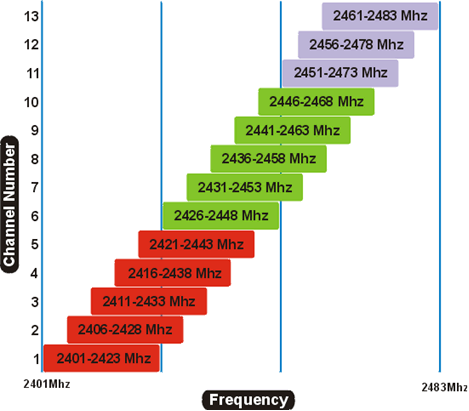
The closely overlapping channels of the 2.4Ghz Band.
So, is a 5GHz band better than 2.4 GHz band?
There is no right or wrong answer to this question. It depends on a number of factors including:
- RF interference (Radio Frequency Interference) – Interference from baby monitors, bluetooth devices and microwave ovens
- Object Interference – the presence of walls, filing cabinets and other furniture.
- Distance from Router / Access Point to Users – The distance from the router or access point to the users will be a key factor in deciding whether to go with a 2.4Ghz or 5Ghz network. In an open plan office, a 5Ghz router will have greater range. In a space where the signal has to penetrate walls, shelving, ceilings and office furniture a 2.4Ghz router will have better range. It all depends on the environment.
The best way to find out is to conduct a wireless site survey.
Why does 5Ghz suffer less RF interference?
The 5 GHz band has 12 non-overlapping channels each with 20 Mhz of bandwidth.
Compare this 2.4 GHz band which only has 3 non-overlapping channels and is subject to congestion from cordless phones, IP camera, microwave oven and baby monitor signals.
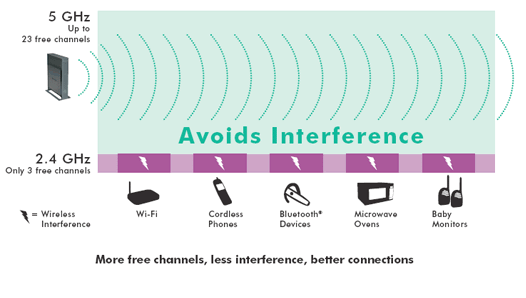
Why a 5Ghz router is not always the best choice?
Look at some frequency ranges and their power to penetrate solid objects. As you can see as you move up the spectrum the power to pass through objects becomes reduced. In other words, as a wave tries to move through an object thicker than its length, it can't.
100Mhz (FM Radio range) - 118 inches
700Mhz - 16.8 inches
900Mhz - 13 inches
2.4Ghz - 4.9 inches
5Ghz - 2.3 inches
Therefore, even though the 5Ghz wavelength has a much greater throughput of data, once solid object like shelving, filing cabinets, concrete or stone walls get in the way, the 5Ghz signal can get severely attenuated.
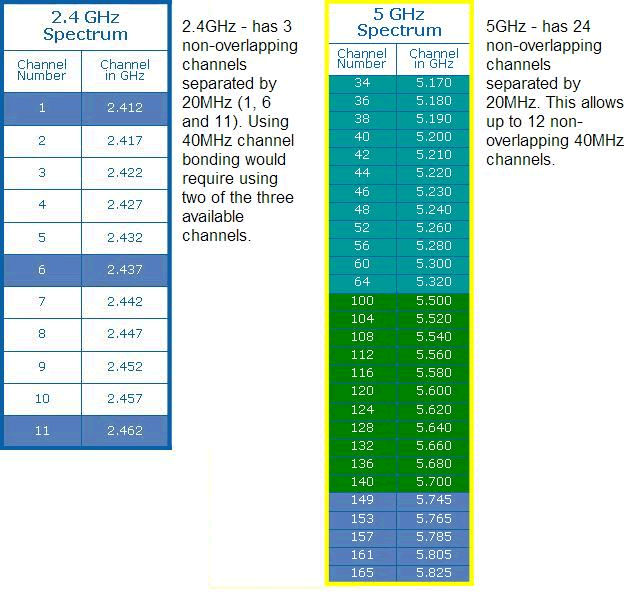
I have a printer that I would like to make wireless but it is not a wireless enabled printer?
A good solution would be to connect the one designated PC to the printer via USB connection and then set the printer to be "shared". Ideally, all operating systems sharing the printer should be of the same architecture. (32-Bit or 64-Bit) One disadvantage of this method is that you have to have the host PC system switched on anytime you want to print. Another solution here would be to buy a router with a built-in USB printer server and attach the printer directly to router via USB connection.
I have two computers connected wirelessly, how do I measure the data transfer speeds between the two?
You can use a free program called Qcheck. It measures network response time, throughput and streaming performance.
What factors should I consider when setting up a wireless network?
Compatibility – How well will all your wireless devices "talk" to each other?
Speed – What sort of traffic will be used on the wireless network?
Range - How far will your systems be placed from the wireless router?
Security – What level of security will be supported?
Budget – What is your budget? Are you looking for an entry-level basic network, mid-range or high-end wireless network?
Future Proofing –Will your wireless equipment be obsolete with the next generation of wireless devices?
How do I know which ports are being used by my system?
Here is a list of some common port numbers used by your system.
Port Number Service Description
20 FTP File Transfer Data (data transfer from server to client)
21 FTP File Transfer (initiation of the session by client)
22 SSH Secure Shell
25 SMTP E-mail (see port 587)
43 Whois queries
53 DNS resolution of domain names into IP addresses
80 HTTP Web server
110 POP3 e-mail collection
123 NTP Network Time Protocol (Protocol for the transmission time)
143 IMAP e-mail access and management
161 SNMP Simple Network Management Protocol
443 HTTPS web server with SSL encryption
587 SMTP E-mail (Alternative Port of Port 25)
993 IMAP IMAPS (see port 143) with SSL encryption
995 pop3s POP3 (see port 110) with SSL encryption
1723 MSN Messenger, MSN Instant Messaging
3389 WindowsRemote Desktop
3478 VoIP (UDP port) Internet telephony
4662 eMule (TCP Port)
4672 eMule (UDP Port)
5050 YIM Yahoo! Instant Messaging
SIP 5060 SIP VoIP telephony
5070 5079 VoIP (UDP ports), Internet telephony
ICQ 5190 ICQ Instant Messaging
6112 Warcraft 3 Warcraft 3 game port (Battle.net)
6667 6669 IRC Internet Relay Chat
8767 TeamSpeak TeamSpeak Voice Chat
30000 30019 VoIP (UDP ports), Internet telephony
Having trouble with your home or office wireless internet?
Computer Ambulance can help. Wireless solutions for laptops, desktops, servers, iPhones, Blackberrys and wireless printers/scanners.
We work with most broadband providers including Eircom, Vodafone, UPC, Smart, Magnet and Clearwire.
Our services include:
- Wireless Survey of your Home or Office.
- Setup and troubleshooting of Small Business Wireless Networks.
- Setup and troubleshooting of Home Wireless Networks.
- Identify and analyse WiFi interference and identify any unauthorised access to your wireless network.
- Install analyze and troubleshoot 2.4Ghz and 5Ghz wireless networks.
- Installation of modems, wireless access points and wireless routers.
- Installation of wireless network adaptors in desktops, laptops and servers.
- Installation of wired access points with CAT5 and CAT6 data cabling.





